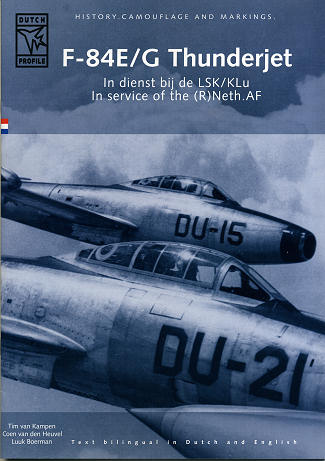 Dutch Profile is a
company that has been releasing books and deals sheets for those books for the
last couple of years. This particular book covers the relatively short life of
the F-84E/G Thunderjet in Dutch service during the early 1950
Dutch Profile is a
company that has been releasing books and deals sheets for those books for the
last couple of years. This particular book covers the relatively short life of
the F-84E/G Thunderjet in Dutch service during the early 1950Dutch Profile #12: F-84E/G in Dutch Service
|
Author: |
Tim van Kampen, Coen van den Heuvel and Luuk Boerman |
| Publisher: | Dutch Profile Publications |
|
Price |
€17.50 from www.dutchprofile.nl |
|
Reviewer: |
 Dutch Profile is a
company that has been releasing books and deals sheets for those books for the
last couple of years. This particular book covers the relatively short life of
the F-84E/G Thunderjet in Dutch service during the early 1950
Dutch Profile is a
company that has been releasing books and deals sheets for those books for the
last couple of years. This particular book covers the relatively short life of
the F-84E/G Thunderjet in Dutch service during the early 1950
The Meteor was the Dutch Air Force's first jet and its pilots were proud of its abilities. However, with the increase in Dutch participation in NATO, it was realized that a newer plane was needed. For this, the Republic F-84 was chosen. Since the new aircraft was to be used as a fighter-bomber, something the Meteor was not equipped for, the Thunderjet was an excellent choice as it was a very stable weapons platform. While not able to dogfight with the then-current MiG-15s and MiG-17s as operated by the Soviets, it would be protected by other NATO assets during its missions.
The first aircraft arrived in 1951 and these two dozen aircraft were F-84Es. The aircraft were without the external bracing later found on the rest of the KLu's F-84Gs, but they were perfect for getting the first squadrons up and operating. Eventually two wings and six squadrons were formed with one squadron being the training unit. As there was no two seat F-84, all pilots soloed on their first flight in the aircraft.
The Thunderjet was well liked by Dutch pilots and several units formed aerobatic teams with the aircraft. Such was the pace of aircraft development, that by 1956, the aircraft was gone from Dutch service with the survivors of the 187 planes being sent to other air forces such as Portugal, Denmark, Greece, Turkey, and Yugoslavia. Two remain in the Netherlands today. A total of 50 aircraft were lost during its short career with the KLu.
Typical of other books in this series, we are provided the history of the aircraft, the reason the Dutch chose it and a short history of the plane's operation in each of the units that flew it. This is accompanied by some superb photos of the aircraft in each different squadron as well as some of the personalities involved. At the end of the book is a chart showing each plane, the code it wore and its eventual fate. A short modeler's section is also included.
We are also provided with several pages of superb full color profiles taken from the photos in the book. Dutch Decal does markings for many of these aircraft in all three major scales, this book being the research source. In line with others in this series, the book is dual language Dutch and English. Unlike many dual language books, the first half of the book is in Dutch and the second half in English. This seems to make the historical section flow a lot better and makes it easier for the editor to properly fit in photographs.
In all, it is like other books in this series and a superb read and reference. It is highly recommended.
September 2011
Thanks to Dutch Profiles for the review sample. Get yours direct.
If you would like your product reviewed fairly and fairly quickly, please contact the editor or see other details in the Note to Contributors.